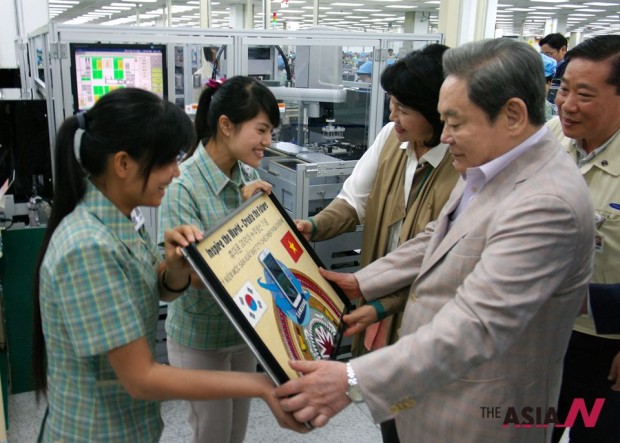Vietnam rises as top smartphone producer

In this file photo of October 2012, President of Samsung Lee Kun-hee talks with employees visiting the Samsung Electronics Vietnam plant in the northern province of Thai Nguyen. <Photo/Samsung Electronics>
Vietnam is becoming a leading smartphone producer in the world as world electronics giants increase investments in Vietnam, Japan’s economic daily Nihon Keizai reports.
According to its recent article, with the Samsung Electronics Vietnam (SEV)’s plan to produce 240 million smartphones in 2013, accounting for 20 per cent of the world market share, Vietnam is following close to China to hold the world’s number one position in this field.
The article attributed the SEV’s selection of northern Vietnam to locate its production establishments to low labour costs and convenient exports of products to important markets such as Japan, China and Taiwan.
In addition to bringing profits to the SEV, this plan will also help Vietnam benefit more from the growth of the electronic industry, create more job opportunities or develop relevant infrastructure. In 2012, Vietnam exported approximately US$13 billion worth of phones and their parts, nearly doubling the previous year’s figure.
The US’s International Data Corporation (IDC) forecasts that the entire world will produce about 918 million smartphones in 2013, of which 50 per cent is made in China.
The overall electronics production in Vietnam including smartphones shows a rapid growth. Vietnam’s Deputy Prime Minister Nguyen Thien Nhan said at the 18th World Electronics Forum held last week in Hanoi that the Vietnamese government considered the industry one of several key sectors to push forward economic growth.
Vietnam’s electronics industry expects to earn US$40 billion from exports by 2017. But while the country’s export revenue from mobile phones, computers and components last year was nearly $20 billion, the industry needs ten years to fully develop, according to Nhan.
As world electronics giants increase their investments in Vietnam, the country is becoming an ever more attractive destination, Nhan said. Intel invested over 1 billion dollars in southern Ho Chi Minh City, with an export value of more than US$1 billion yearly.
Last year, SEV’s export revenue doubled to $12.7 billion, motivating the company to build a new $2 billion plant in the northern province of Thai Nguyen.
Japan’s Panasonic poured 4 billion yen ($3.95 billion) into the construction of an electronics and electric component production plant in the southern province of Binh Duong, while China’s Winter invested $870 million in a touch display production plant in the northern province of Bac Giang.
Vietnam’s export revenue from mobile phones, computers and components reached nearly US$20 billion in 2012, out of the total export value of US$114.5 billion, according to the Vietnam General Statistics Office.
Le Ngoc Son, Chairman of the Vietnam Electronics Industries Association said that Vietnam’s electronic industry is facing a big challenge when the sector’s export value is high, 90% of which was recorded by the FDI sector while the remaining 10% by domestic companies.
That requires international support in market expansion, human resource training, competitiveness increase and cooperation for development of the support industries and participation in the global value chain, he added.

























































